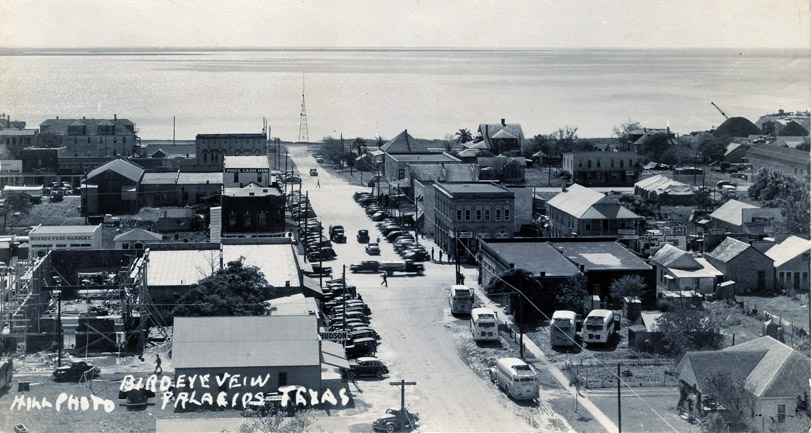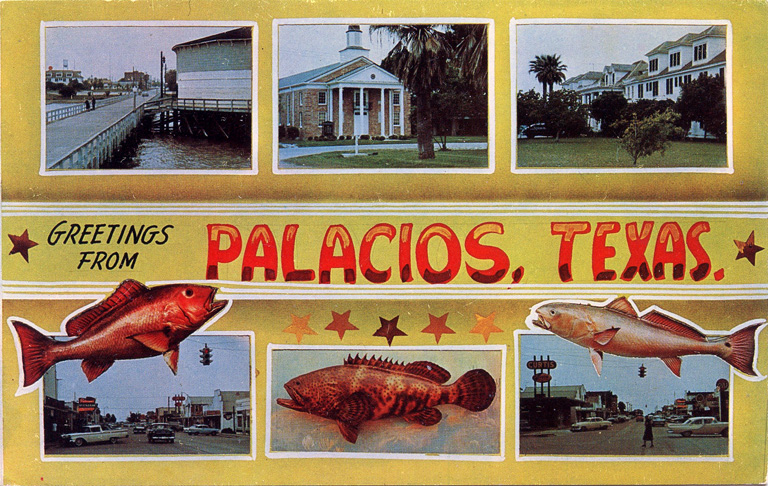|
Located on the
southeastern coast of Texas, on Tres Palacios Bay, an
intrusion of the Gulf of Mexico, is the finest summer and
winter resort on all the gulf coast; is the geographical
center of the midcoast section of the state; is an ideal
location for homes; is the marker and supply center for a
wide area of the richest farm and fruit lands in the South;
is practically a new city, with exceedingly progressive
people and superb opportunities. The settlers occupying the
contiguous and adjacent farms and the citizenship of the
city comprising a section that is in reality a rapidly
advancing territory with every attraction for permanent
residents, are farmers, homeseekers, workers, operators of
industries, fruit growers, as well as transient, visitors
for summer and winter.
 Palacios was located
by its founders on account of its ideal location and
advantages for a city of homes--a healthful delightful and
desirable place in which to live. The deep blue salt waters
of the great ocean wash its shores, yet it is located as far
inland from the open sea that danger from tidal waves or
coast storms is impossible. Palacios was located
by its founders on account of its ideal location and
advantages for a city of homes--a healthful delightful and
desirable place in which to live. The deep blue salt waters
of the great ocean wash its shores, yet it is located as far
inland from the open sea that danger from tidal waves or
coast storms is impossible.
As a summer resort it
fronts south on the bay, the prevailing south breezes from
off the gulf have unobstructed sweep to the farthest limits
of the city, and the bathing and dancing pavilion extends
100 feet out into the bay, where one can enjoy the
advantages of fine salt water bathing and delightful pastime
in boating and fishing.
As a winter resort a
more delightful place during the winter months does not
exist. The rigors of the bitter cold of the North are never
known; the blizzard does not come, yet it is the sportsman's
paradise, as the wild geese, ducks, quail and other game are
here in countless numbers.
For healthfulness this
particular section stands without a peer in any part of the
world. There is nothing locally to cause disease, the
country being elevated above the sea some eighteen or twenty
feet on an abrupt bluff, drains easily and naturally, and
hence is free from malaria. Another element which
contributes to the health of the people is the pure artesian
water, coming from a depth of from 300 to 700 feet, as clear
as crystal and as soft as rain water.
All the staple crops
of the South, besides many others, grew in prolific
abundance. These include, rice, cotton, corn, Kaffir corn,
broom corn, sugar cane, sweet potatoes, Irish potatoes,
peanuts, cabbage, cauliflower, onions, tomatoes, beans, peas
and everything else in the vegetable line, besides the
matchless Satsuma orange, Magnolia and other varieties of
figs, Tokay grape and other fruits. See article on "The
Grape, or a New Industry for Palacios."
Aside from the retail
mercantile business, of which all lines are represented with
full and complete stocks, Palacios includes many enterprises
and industries of which we enumerate the following:
Oyster packing and shipping, 2
Ice factory, electric light plant and cotton gin
Ship yards
Machine shops, 2
Planing mill
Tin shop and sheet metal works
Waterworks
Cement block plant
Telephone exchange
Nurseries, 3
Well drillers, 2
Plumber and gas fitter
Lumber yards, 4
Banks, 2
Steam laundry
Churches
Public library
Livery and transfer, 2
Hotels, 6?
Commission merchants, 2
Warehouse
Newspaper
Baker
[ad at right
Palacios Beacon, September 14, 1923]
That Palacios is
destined to become a large and important seaport at no
distant day is apparent to every one who gives the subject
any thought. We are in direct connection with the great
Intercoastal Canal from the Mississippi River to the Rio
Grande, and which is now under construction and will be
completed in the next eight months, giving us an inside
route from Galveston to Corpus Christi, and besides our
regular train service, at present consisting of one daily
mail and express train and a mixed train daily except Sunday
over the Southern Pacific Railroad, we have a regular
freight service between Houston and Galveston, at a cost of
about one-half the rail freight rates. This service is
furnished by the auxiliary schooner Margaret of
eighty tons capacity.
Palacios High School
In educational
facilities Palacios ranks with the best cities in the state;
in fact, the fame and superiority of our public schools has
been one of the great incentives which has induced many of
our best citizens to locate here. The present enrollment is
between 400 and 500. The complete course embraces eleven
years work--eight grades and three years high school. The
high school course is complete in every respect and
graduates are admitted to our universities on their high
school certificates.
B. Y. P. U.
Encampment Grounds
Projecting out into
Tres Palacios Bay upon a peninsula is one of the most
attractive encampment grounds upon the gulf coast, where
hundreds of young people, and old as well, assembly here
every year to hear some of the ablest speakers of the
Baptist Church in the United States. This tract formerly
known as Hamilton Park, is owned by the Baptist Young
Peoples' Union of Texas. In the center of this park is the
auditorium in which may be seated over a thousand people.
Palacios College
Palacios College was founded in 1905 by Rev. William H. Travis, who
continued as president until January, 1907. In September of that year
the work was resumed with Rev. M. M. Wolf as president, and has
succeeded under this management and is destined to be one of the
foremost colleges in this section of Texas. In June of the present year
the correlation with the Baptist schools of the state was effected and a
girls' hall erected at a cost of $20,000. The growth of the school has
been steady. Each year has brought improvements and the widening of the
sphere of its usefulness. It has had its share of hardships incident to
school building. It enters this school year upon a distinctly new era.
First of all, the correlation gives a permanency to the work beyond
anything that could have happened, and with the completion of the girls'
hall has brought an enlargement of the faculty in every department. The
school offers its constituency a course of study modeled after the best
academics of the country have all the improving factors which determine
their fitness for patronage, yet Palacios College has had that
distinction from the beginning. Situated on the beautiful Tres Palacos
Bay, it has a healthful climate, moral atmosphere, cultured society,
spacious buildings, well-equipped laboratories, well supplied library,
equipments and a corps of efficient teachers and the most important of
all is the water supply which is abundantly supplied by one of the
finest artesian wells in the state. For further information write M. M.
Wolf, President.
The Fish and Oyster
Industry
Very few people even
in our midst, realize what an important factor this industry
is, yet the facts and statistics given are astonishing to
the average person. Last season there was marketed through
our fish and oyster firms 70,000 pounds of fish, 12,000
barrels of oysters, which required 30 boats and a total of
125 men to man the boats and prepare and ship the fish and
oysters. The sum of $21,500? was paid for labor, divided as
follows: Boats and men in handling oysters, $12,000; fish,
$4,500; shucking and packing $5,000?.
Ice, Electric Light
Plant And Cotton Gin
Since the purchase of
this enterprise by Mr. D. C. Deal the plant has undergone a
thorough overhauling, and besides enlarging the ice
machinery to a twelve-ton plant there has been added a
complete system of refrigeration, consisting of three rooms,
two of which are 8x8x21 feet and a larger one 12x8x21 feet,
and is operated to its full capacity. Besides supplying the
local trade, large quantities are shipped to other points in
the bays. The electric light plant is supplying in the
neighborhood of 600 lights and each day adds other
consumers. The cotton gin has ginned so far this season 300
bales and the crop is only half picked.
For detailed
information, write to H. B. Farwell, manager Palacios City
Townsite Company; Charles R. Morris manager Morris Land
Company; D. W. Grant, manager Palacios Land and Investment
Company; S. T. Beat? Merchants and Planters Lumber Company;
Palacios State Bank; State Guaranty Bank and Trust Company;
Ruthven Packing Company; D. C Deal, proprietor ice plant; M.
M. Wolf, president Palacios College, or to the Board of
Trade.
Galveston Daily
News, November 6, 1911
|





